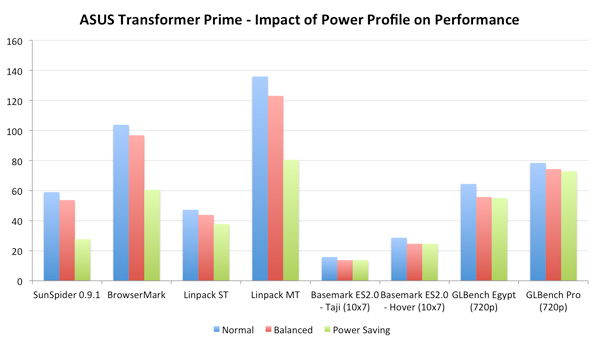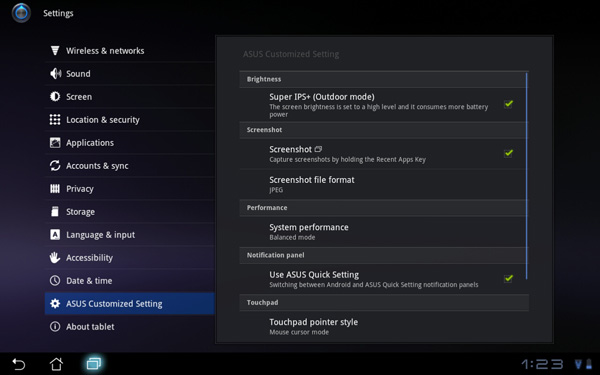ASUS Eee Pad Transformer Prime & NVIDIA Tegra 3 Review
by Anand Lal Shimpi on December 1, 2011 1:00 AM ESTThe Three Power Profiles
There are three power profiles ASUS and NVIDIA have defined on the Prime: Normal, Balanced and Power Saver. Normal allows the CPU to run at up to 1.4GHz with only a single core active, and 1.3GHz otherwise. Balanced is the default setting and it drops maximum CPU clock to 1.2GHz and favors lower clock/voltage targets on the curve compared to Normal mode. Power Saver caps CPU frequency at 1GHz with 1 - 2 cores active, 760MHz with 3 cores active and 620MHz with 4 cores active. It's unclear what the impact is on GPU clocks/performance.
Regardless of power profile, video playback capabilities are untouched - all profiles are able to play 1080p High Profile H.264 content at up to 40Mbps.
The performance impact of these various profiles varies depending on what you're doing. I ran a mixture of CPU and GPU bound tests in all profiles to measure their impact. The results are below:
I reformatted the SunSpider and BrowserMark scores to keep the magnitude of the numbers in line with the rest in the chart, and to make higher numbers = better performance across the board. For the most part you can see that the difference between Normal and Balanced is pretty small. Numerically it works out to be a 5 - 15% gap depending on the benchmark. The latter end of the range is big enough where the performance conscious will want to stay in Normal mode, but it's possible to do without it.
It's interesting to note that the impact on GPU performance isn't that major across the board. It looks like NVIDIA is primarily modulating CPU speed here. The impact on JavaScript rendering performance is huge when you enable the Power Saving mode. In this state the Prime performs like a Tegra 2 based Gingerbread phone.
Power Profiles & Super IPS+ Toggles
Unlike (far too) many of its competitors, ASUS limits its customizations to those that are almost purely functional. ASUS is clearly aware of the fine line between useful improvements and clutter.
The most obvious customization is in the Quick Settings tool:

ASUS' implementation is far busier but it's all extremely useful. You get one tap access to Super IPS+ mode, as well as one tap switching between Power Saving, Balanced and Normal power profiles. I'm pleased to report that toggling any of these modes is pretty much instant, there's hardly any lag between when you tap a button and its impact takes effect. Response time is a particularly important as it directly impacts how frequently the tool is used. In this case I have no issues switching between power profiles because it's pretty much effortless.












204 Comments
View All Comments
steven75 - Saturday, December 3, 2011 - link
But what reason can you give for not getting an ipad? Too much software selection? Too great of an ecosystem? Too much wireless video streaming to your TV? Too high of resale value? Too easy to use?Curious minds want to know!
BillyBobMcgrath - Monday, December 5, 2011 - link
How about bad value for money? For the price of a 32GB Prime you get a 16GB iPad 2. It has roughly half the specs of the Prime: only 0.5GB memory, dual core processor v.s. quad core, lower resolution and screen size (which is REALLY annoying for watching 16:9 ratio videos, which is to say more than 1/2 shows/movies you can buy/download) and lack of expansion slots.In terms of software, iPad is smoother than android but at the same time you get a very limited browsing experience with iOS. I know HTML5 is the "future" but at the present is still dominant and will be for a while.
As for apps, whilst there are less app choice, It has a good range - you may have less choice in each department than iOS but you will always find apps suitable for your needs.
Build quality, at least for the prime, is also a lot better than the iPad's. Whilst both use aluminum instead of cheap plastic, the prime uses Gorilla glass rather than normal glass.
For $500, the transformer prime gives you a much, much better product. Apple products are very good and generally blows away low-mid range non apple products but when you compare apple's products to similarly priced alternatives, they just don't deliver acceptable quality for your money.
For example, a current generation MacBook pro 15" costs £1.6K. A HP 15" with virtually identical specs costs £800. The inclusion iOS does not justify a 100% markup on a windows PC. FOr £1.6k you can buy a laptop much, much more powerful than the £2k MacBook pro. The iOS may be better but is not worth £800. Furthermore to get full functionality out of a Mac you have to buy windows for bootcamp, which is another £120. By choosing a similarly priced alternative to apple products you "miss out" on an apple OS but gain much better specd products. I don't mind paying more for a better product but I expect the quality of the product to match the price and you just don't get that with Apple.
simad57 - Friday, December 2, 2011 - link
One criticism of the original Transformer was that the charging cable was too short. Have they addressed that issue with the Prime? If not - is a USB extension cable a reasonable solution to address a too short cable or is there an issue with the about of current being pushed down the cable to charge the tablet in a shorter time than the mini usb.Stas - Friday, December 2, 2011 - link
That is a fantastic screen! I'm very surprised and impressed.user777 - Sunday, December 4, 2011 - link
1) G3 USB stick testThere were a lot of questions regarding the G3 version of the tablet.
Is there a possibility to test any G3 USB stick on the Transformer Prime dock (example 50 USD/euro G3 usb stick from Archos G9)? It would answer all these questions.
2) Skype video call test
Skype is may be the most popular video app available for a lot of Android devices. Would it be possible to make a Skype video conference call test and confirm if the Skype app works with video on Transformer Prime?
3) MX Video Player test
I really like the MX Video Player which also has full support for multi-core processors, subtitles, mkv/m2ts/mp4/... file formats, etc. Is it possible to test MX Video player too?
user777 - Sunday, December 4, 2011 - link
The possibility to play multi format video files is indeed excellent feature of the Transformer Prime.Since the video file are quite large in size playing them from a home DLNA server via WiFi is important too (example Vuse torrent client DLNA server and playing by any third party DLNA client app like Skifta, iMediaShare, Bubble UPnP). Is it possible to test the DLNA video streaming of 720p/1080p videos?
lancedal - Sunday, December 4, 2011 - link
for tablet/smartphone market, except Apple. Why? because it's so software/os dependent. With an open platform like Android/Window, it's very hard to harvest the extra resources.If you look at the PC market, the quad-core is for heavy gaming and server while the dual-core is the most generic CPU for every laptop/desktop out there. And that is with a matured market with matured OS and application.
I would doubt that Apple would go quad-core, but they are the only one can do it because they control both software and hardware. The rest? stick with dual.
ProDigit - Sunday, December 4, 2011 - link
Having a quadcore fast machine is good!However, there are not sufficient programs out there, really needing all that performance!
Most programs are smaller apps you can run with a single core running half the CPU speed!
And most games, 3D games run perfectly fine on a cortex A8 or A9 processor.
A pitty that software for Android is lacking behind!
Lucian Armasu - Sunday, December 4, 2011 - link
That's the whole Asus Transformer Prime. It can use an integrated keyboard dock, to look much like a Zenbook. The hardware is similar.kamm2 - Monday, December 5, 2011 - link
"Scrolling is rarely as smooth as I'd like it to be via the dock's trackpad. Many times the gesture just won't register on the trackpad or the trackpad will detect my two fingers but it won't scroll."We have this problem with my wife's Eee PC netbook. It is very annoying. We are looking to replace her aging notebook and will not be buying one without scroll bars on the trackpad. The probably means no Asus. The trackpad is also hyper sensitive so it makes accidental touches while typing a nightmare. There seems to be no sweet spot when adjusting the sensitivity. This is in contrast to the trackpad on her first generation Eee PC which is excellent.